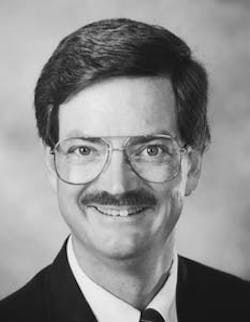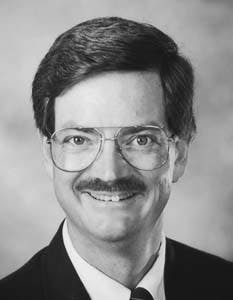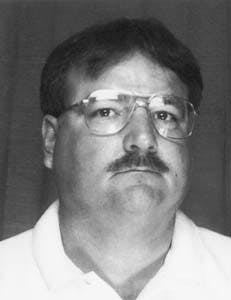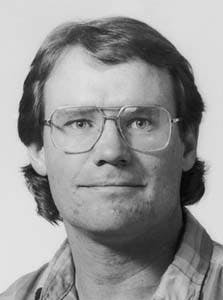Practical Drilling Technology Foamed cement job successful in deep HTHP offshore well
O. Glen Benge
Mobil E&P Technical Center
Dallas
Jim R. McDermott
Mobil E&P U.S.
New Orleans
Joey C. Langlinais
Halliburton Energy Services
Houma, La.
James E. Griffith
Halliburton Energy Services
Duncan, Okla.
A foamed cement slurry successfully isolated problem formations behind a liner in a high-temperature/high-pressure (HTHP) well in Mobile Bay.
The foamed cement slurry, with an average density of 11.8 ppg, was used to cement about 10,000 ft of a 95/8-in. liner.
Foamed cement has classically been considered when light-weight slurries are required. In this application, the use of foamed cement was not for its light-weight properties but rather for its unique performance in high-stress environments.
Both offshore and zero-discharge requirements had to be met, and special considerations for each were addressed in this operation.
The Mobil E&P U.S. drilling department in New Orleans set a world offshore cementing record by using foamed cement on a 95/8-in. drilling liner on the Mary Ann 95.5 well in Mobile Bay. The liner was set at 18,140 ft with the top of the liner at 8,184 ft. The foamed cement slurry was used from the top of the liner to 500 ft off bottom.
This is believed to be the world's deepest offshore application of foamed cement, and one of the few foamed cement jobs ever performed in an offshore environment. (The deepest land application found in a literature search was an 18,884-ft well in Wyoming.)
Mobile Bay wells present a unique set of operational and technical problems. These wells are high-temperature gas wells that typically have producing wellhead temperatures in the range of 300 F.
There are a number of intermediate zones in the well that can cause other problems (Fig. 1 [133534 bytes]). The Ferry Lake formation has a calcium chloride water flow that has a pressure exceeding 17 ppg and is isolated by the 95/8-in. drilling liner. This high-pressure, low-volume zone can cause pressures behind and at the top of the 95/8-in. liner.
Due to the water flows near the top of the liner, a seal in the liner overlap was considered critical. Without a seal at this point, the integrity of the tie back can be compromised, and pressure on the tie-back annulus can occur. Temperature-induced failure of the cement seal can also occur in the tie-back annulus during further drilling because of increases in temperatures in the well bore.
Previous research has shown benefits of compressible slurries in preventing flow after cementing.1 The study was geared toward gas flow rather than fluid flow, but additional work indicates that foamed cement can be effective in preventing both gas and fluid migration. Based in part on this work and the study on temperature-induced stress failure of cement, a foamed slurry appeared to be an appropriate choice.
In an attempt to address these problems, a 15.0-ppg Class H cement system foamed with nitrogen was used on this liner job. Because of the high temperatures in this well, the slurry was stabilized with 35% silica flour. Other additives for retardation, foaming agent, and foam stabilizers were added as liquids.
Why use foam?
The goal of this cement job was to get a specially formulated foamed cement above the top of the liner, throughout the overlap, and into the open hole below the Ferry Lake formation. The cement system was a nitrogen-foamed cement that had been designed by Mobil and Halliburton Energy Services to prevent stress cracking in the cement because of temperature and pressure cycles.
This particular job used a constant nitrogen injection rate rather than a staged nitrogen injection. The base slurry was a 15.0-ppg Class H blend stabilized with silica flour and surfactants for the foam. The tail cement used the same base slurry without surfactants or nitrogen.
The design of a foamed slurry to prevent cement cracking has been shown in recent research to depend on foam quality and composition of the base slurry. For this job, foam quality, rather than density maintenance, was the primary concern, which allowed use of a single nitrogen rate for the entire job. Although the foam quality varied throughout the length of the cement column, it remained in the acceptable range that had been defined. Additional research is on-going to define better the acceptable ranges of foam quality and slurry composition.
Foamed cement has classically been considered when light-weight slurries are required. In this application, there was no requirement for a light-weight slurry, but rather the foamed cement was used for its apparent resistance to temperature and pressure-induced stresses. Work for this and other projects on foamed cement has shown it to exhibit a number of unique physical properties that give it an advantage in these well conditions.
Pressure-induced stress failure occurs when these same annuli are exposed to stresses brought on by pressure in the internal casing. These stress failures generally occur during fracture treatments down casing and are not a problem in these wells. Other sources for these stress failures occur during casing tests, especially in larger casing sizes. Pressure-induced cement sheath failure was well researched and reported on by Goodwin and Crook.2
Temperature-induced stress is brought on through heating of a closed system. These conditions occur when the well is placed on production and are most severe in the upper portions of the well. At the wellhead areas in Mobile Bay, the cement temperature will increase from 80 to 300 F. in a very short time. This increase in temperature causes the stress failure of the cement and results in a loss of the seal in the tie back annulus. Continued drilling can also cause temperature increases up hole, yielding the same problem.
Temperature-induced stress failure of the cement appears to occur only in a closed system. If the cement is across from a formation, there may be enough "give" of the formation to prevent failure. The closed system in these wells is as simple as a well-cemented liner top or tie-back string. Any point in the well where there is a cement sheath in the annulus between two strings of pipe, the potential for temperature-induced stress failure exists.
On-going work has shown that temperature changes typically seen in HTHP wells can cause pressure changes in the annulus on the order of 15,000 psi. This change is caused by heating the closed system that exists in the tie-back string and at the liner overlap. These large pressure increases can result in cement failure, leaking connections, or casing collapse.
This pressure from the temperature increase must be reduced or eliminated to prevent casing or cement problems. Venting the pressure at surface will suffice if the annulus has not been cemented and contains a fluid column. Other options include incorporation of a gas cap using some type of collapsible material in the annulus to absorb the pressures.
Considerable effort has been made in the area of eliminating or controlling temperature-induced stress failure of cement. Laboratory work into prevention of stress-induced failures has shown that certain foamed cement slurries appear to exhibit unique properties with regard to stress-induced failure. When properly designed, they can prevent these problems in HTHP wells. Research is continuing on the use of foamed slurries for prevention of failure from both temperature and pressure-induced stress failure.
Operations
The operation consisted of three separate parts:
- First was the mixing and pumping of the base cement slurry. The job used a Halliburton Automatic Density Control (ADC) unit with an RCM II cement head. This particular unit allows for control of cement density and pumping rate at the same time, both of which were critical to the job.
- The second part of the job was the injection downstream of the foamer and foam stabilizer by using a separate liquid-additive pumping skid and injecting the additives into the suction side of the triplex pump on the cement unit.
- The final part of the operation was the injection downstream of the nitrogen.
The final foam quality depends on the base slurry cement density, cement slurry pump rate, foamer and stabilizer injection rate, and nitrogen rate. Each of the variables was controlled from a central point using a computer feed into a Halliburton Compupac unit.
Each individual part had one person in charge of a particular piece. The cement unit operator only had to worry about getting a cement slurry delivered at a constant rate and density. The liquid pump skid operator needed to ensure proper liquid additive rates and ratios, which was accomplished by an automated injection system that maintained the additive rates based on the cementing rate and automatically adjusted the rate to compensate for changes in the cement rate. Finally, the nitrogen unit operator only needed to deliver nitrogen at a particular rate based on the cement pump rate.
Breaking the job into several individual parts relieved the operators of the need to coordinate the total job and left the overall job coordination to one Mobil and one Halliburton representative. It was agreed before the job started that if any problems occurred or any changes had to be made, the personnel would go through one of two people. This setup prevented the confusion that can easily occur on any complex job.
Fluid volumes
Several fluid calipers were run prior to the job. All but the last caliper showed a 14.6-in. open hole, which is consistent with offset wells. The final fluid caliper indicated a 15.25-in. open hole. Based on this caliper, additional cement and nitrogen were ordered for the job.
This additional material also required bringing out additional cement storage, since all of the tanks on the rig were full. The additional cement tank was placed on the deck, and plans were made to transfer cement to the rig bulk system during the job. The alternative to this setup was to attempt to transfer from the supply boat during the job. Because of potential operational and weather problems, transferring from the supply boat during the job was not considered a viable alternative. A separate compressor for the extra bulk tank was brought out.
Fluid volumes can be critical in foamed cement operations. The yield of the final foamed slurry depends on the base slurry volume, nitrogen volume, and the slurry location in the well. Foamed cement is compressible, and the "yield" of the slurry increases as pressure is relieved on the slurry.
An accurate hole volume was very important in this situation because the goal of the job was to place foamed cement at the liner lap and on top of the liner. If too little cement were used, then the liner lap would not be covered, and alternatively, excess foamed slurry could result in very large volumes of cement on top of the liner.
Cement volume excess poses an additional problem unique to this location. Mobile Bay wells are drilled with zero discharge, and any fluid coming from the rig must be caught in barges and transported to shore for proper disposal. Excess volumes add directly to disposal costs.
The foamed slurry was designed to be stable at downhole conditions and would not be stable at surface. Had the slurry been circulated to surface, the expansion of the nitrogen in the slurry would have resulted in a surface foam density of less than 1 ppg. This could have created problems in dealing with a large unstable foam fluid going into a barge.
Nitrogen injection
Spotting equipment on the offshore rig posed some operational challenges. Originally, the liquid nitrogen tanks were to have been spotted on the upper cantilever deck with the nitrogen unit one deck down. Although acceptable, this arrangement would have separated the nitrogen portion of the job into two distinct areas with the person running the nitrogen unit unable to see his assistant on the nitrogen tanks.
Some of the rig equipment was moved to work boats, allowing all of the nitrogen equipment to be located on the lower deck. This arrangement also allowed for an easier hookup, as the nitrogen was injected into the standpipe under the cantilever deck which was 20 ft from the nitrogen unit. Alternative rig-ups would have required nitrogen injection at the rig floor.
The nitrogen operator had a complete rate sheet on the unit and a real-time readout of the cement rate. This information allowed the operator to make the appropriate changes in the nitrogen rate to match the cement rate. Direct observation of the rates on the nitrogen unit confirmed that the injected volume agreed with the design sheets.
The injection pressure and rate from the nitrogen unit were transmitted back to the main computer and recorded. The computer then calculated an estimated downstream injection density from the cement and nitrogen rates. The reading at the main computer for nitrogen rate was not in standard cubic feet per minute, but in absolute cubic feet.
This readout was useless for determining downhole injection rates or injected densities. The number displayed was in the range of 15-25, while nitrogen injection was approximately 2,000-3,300 scf/min. Different computer parameters should correct this problem.
During the last 20-30 bbl of lead slurry, the nitrogen volume was reduced to two-thirds of the designed amount to conserve nitrogen. The volume of nitrogen on location was sufficient to perform the entire job, but due in part to the pressure test with nitrogen of the treating line, there may not have been enough material on location had the rate not been reduced. After the nitrogen rate was reduced, a cement delivery problem occurred, and the lead slurry was cut short by 20 bbl.
Mud removal
The liquid-additive pumps for the surfactant and foamer were located on the same deck as the nitrogen unit and tanks. This setup required plumbing the surfactant pump into the suction side of the triplex pump on the cement unit one deck down. The cement unit and associated bulk equipment were below deck in the cement room, and all other equipment were on the upper deck of the rig. The final result was that all of the equipment for the cement job was located in two areas. Communication among the three areas was done through hand-held radios.
Initial plans were to foam the spacer, or at least the last 10-20 bbl of spacer. This plan will work if the spacer line can be routed through the triplex pumps without going through the displacement tanks on the cement unit. On most offshore rigs, the spacer is mixed in the slugging pit, and there are no lines hooked directly into the cement unit.
Foaming the spacer would have required pumping the spacer to the displacement tanks on the cement unit, pumping it into the well, then shutting down to clean the cement unit. Because these steps would have required shutting down the nitrogen unit, the spacer was not foamed.
The other alternative would have been to reroute the nitrogen into the mud line to the rig floor. The arrangement of the cement head was such that the mud displacement was done through the top drive and not the cement valve. Again, this would have required shutting down to switch lines and was not considered a viable alternative.
Although a foamed spacer can give better mud removal, overriding operational problems prevented the use of foamed spacer on this job. The mud was circulated prior to the cement job for 12 hr rather than the original plan of 4 hr. This additional circulation probably improved mud removal as much or more than foaming the spacer and could be done with no operational problems.
Cement slurry
The only problem of note that occurred during the job had to do with bulk cement delivery. All of the cement could not be held in the cement tanks on the rig, and an additional portable cement tank had to be put on an upper deck. The delivery of cement from this tank was not sufficient to keep up with the required mixing rate, so some of the lead foamed slurry was cut short. This change did not affect the success of the job, as foamed cement was found on top of the liner during drill out.
The results did point out that on future jobs the lead or foamed base slurry should be placed in the rig tanks and any tail slurry in a portable tank. (This assumes that the same hookup and equipment are used on future jobs.)
The mixing and pumping rate for the tail slurry are not critical because it is not foamed. If the lead slurry mixing rate is reduced, it results in a need to change the liquid additive injection and the nitrogen injection rates. The nitrogen units used have a minimum effective controllable rate, and below this rate the delivery of nitrogen becomes very difficult. Thus, cement must be mixed at a predetermined minimum rate to maintain control during the job.
The base cement slurry was mixed with an 8-bbl RCM II with an ADC control system. An alternative to using a controlled mixing rate from the cement unit is to use a batch mixer for the base cement slurry. In this way, the actual mixing rate of the cement is less critical, because the pump rate of the base slurry is independent of the mixing rate.
Offshore there can be a problem with space for spotting the batch mixing equipment, and on this particular job no batch equipment was used. Earlier work3 has indicated that the ADC cement mixing unit is capable of delivering a cement slurry at both a desired density and rate. Because of this work, the inherent risks of not using a batch mixer on this job were greatly reduced.
Although this job was a successful continuous mix operation, had a batch mixer been used, the cement delivery problem would not have been a concern. Operationally, the extra tank of cement would have been mixed first into the batch mixer without regard to rate.
Of a lesser concern, the control of the liquid additives is also affected by the cement pumping rate. Changes in this rate affect this portion of the job as well, and minimum delivery rates from this equipment could have also been a problem with very low cement mixing rates.
Operational concerns
Some other operational concerns came to light prior to the job, and these problems should be addressed on future jobs. The simple operation of pressure testing cement lines takes on new meaning when an energized fluid like foamed cement is pumped. Testing the lines with water was considered inadequate, and an additional pressure test with nitrogen was performed before the job. Pressure testing with nitrogen gave more confidence in the integrity of the treating system.
For jobs that use foamed cement, it is recommended that the lines be pressure tested with nitrogen. On this job the treating line was tested with both water and nitrogen. The 5,000-psi water test did not indicate any leaks in the system. The 3,000-psi nitrogen test indicated two small leaks which were isolated and repaired. Without the nitrogen test, these leaks would have gone undetected.
Testing the line with nitrogen should be incorporated into these job designs, and the volume of nitrogen required for testing should be added to the total volume on location.
The rig used a high-pressure coflex hose for a cementing line, but safety concerns with regard to the coflex hose dictated the use of treating iron to the cement head. Foamed cement can be more abrasive than conventional slurries, and it was felt a steel treating line would add an additional degree of safety.
Plans were to use the coflex hose if problems occurred in the treating line. This plan required getting additional valves and fittings to the rig. No delays were caused on this job because of the change in hookup, but that potential should be anticipated on future jobs.
For future jobs, the use of a treating line rather than coflex hose should be planned for, and the required fittings should be sent to the rig well in advance of the job. If a foamed cement job is pumped from a boat or barge, foamed cement may have to be pumped through a coflex hose. The concern about use of a coflex hose with foamed cement should be addressed prior to any such job.
The location of the nitrogen and liquid additive tanks and units was changed to allow for all of this equipment to be spotted on one deck. This setup proved critical, as the rate sensor from the nitrogen unit was not being properly fed to the computer, requiring manual communication of the nitrogen rates.
Communication during the job was accomplished through radio links with critical personnel. The cement unit operator, nitrogen operator, and surfactant pump operator were all connected via radio link to the engineers controlling the job.
Finally, good preplanning was a critical key to the success of this operation. Several prejob planning and safety meetings were held with all hands, with each person knowing his role in the operation.
Job evaluation
The goal of the cement job was to place foamed cement across the liner lap and on top of the liner. There are a number of postjob occurrences that confirm that the goal of the job was accomplished.
While tripping back in the hole after waiting on cement, no nitrogen was found above the cement. This was either an indication that no foamed cement was circulated above the top of the liner, or if foamed cement was in place, that the foam was stable and there was no nitrogen breakout from the cement.
On drill out at the liner top, little resistance was encountered. The bit did not wash to the top of the liner, but hard cement was encountered. This hard cement was expected because the cement at this density and temperature should have had a compressive strength of approximately 300 psi.
Some gas was seen in the returns during drill out, indicating that foamed cement had been successfully circulated above the liner top. Pressure testing at the liner top was successful but was no indication of a successful cement job because an integral liner top packer was part of the hydraulic liner hanger system.
The location of cement on top of the liner was also significant because additional cement was brought out to location based on the final fluid caliper. If volumes from offset wells had been used rather than the fluid data from this well, the volume of cement used on the job would not have been sufficient to bring cement above the liner top. Similarly, the lack of excess cement on top of the liner again validated the final fluid caliper.
Drilling continued on this well for an additional 6 months following the cement job. In that time, no pressure was found on the tie-back string. The presence of the liner top packer precludes any conclusion as to the long-term sealing ability of the foam slurry in this well.
During the continued drilling operation, several ultrasonic inspection logs were run on the 95/8-in. casing to evaluate casing wear. The initial log was used for cement evaluation and indicated the presence of a gas layer followed by water below the liner top packer.
The log showed good foamed cement in the overlap, indicating that the foamed cement was stable at the downhole conditions. It is unclear why the logs indicated the presence of gas and water, which indicates foamed cement instability, in the upper sections of the overlap. This may be due to the relief of the hydrostatic pressure on the foam following setting of the liner top packer. Review of the logs and cement job is continuing.
The goal of this cement job was to get a specially formulated foam cement above the top of the liner, throughout the overlap, and into the open hole below the Ferry Lake formation. The presence of a gas pocket immediately below the liner top packer will still allow a pressure relief area for temperature-induced pressures. The logs indicate a competent foam in the overlap with no channels through the cement, indicating isolation of the Ferry Lake formation.
Recommendations
Based on the experience gained from this offshore foam cement job, the following recommendations and observations can be made:
- The foamed cement should be pumped through a treating line rather than a coflex hose. This and any other safety issues must be resolved prior to the job.
- The bulk system and the delivery of cement to the unit should be evaluated if cement volumes above rig capacity are required.
- Some of the sensors from the nitrogen unit did not allow for remote readout of the actual nitrogen rate. The sensors on the computer may need modification to allow readout of nitrogen delivery in standard cubic feet per minute.
- The treating line should be tested with nitrogen, and excess nitrogen volume should be on location to account for the test volumes used.
The use of nitrogen to pressure-test the line allowed for repair of any leaks that may have gone uncorrected had only a hydrostatic test been performed.
- Initial plans called for foaming a spacer as well as the cement. For offshore locations, foaming of the spacer is operationally very difficult, and if required, alternative mixing and pumping systems may be necessary. Because of this difficulty and the fact that hydrostatic pressure was not a concern in this application, a nonfoamed spacer was used ahead of the slurry.
- Fluid or open hole calipers help determine hole volume, which is critical for foamed cement operations.
Acknowledgment
The authors wish to thank the Mobil E&P U.S. and Halliburton Energy Services personnel, without whose efforts the success of this unique cement job would not have been possible. The authors also extended special thanks to Mobil drilling supervisors Elray Foret, Philip Thackston, and Adam Lobret for their support and expertise. Additional thanks is extended to the Halliburton laboratory personnel for their work on this project.
References
1. Tinsley, J.M., Miller, E., Sabins, F., and Sutton, D., "Study of Factors Causing Annular Gas Flow Following Primary Cementing," Journal of Petroleum Technology, 1980.
2. Goodwin, K.J., and Crook, R.J., "Cement Sheath Stress Failure," SPE Drilling Engineering, December 1992.
3. Benge, Glen, "A New Technique for Evaluating Field Cement Mixing," SPE Drilling & Completion, June 1995.
The Authors
Glen Benge is a senior staff engineer with Mobil E&P Technical Center in Dallas. He joined Mobil in 1987 in New Orleans and was responsible for Mobil's cementing operations in the Gulf of Mexico.Prior to Mobil, Benge worked for 12 years for Dowell Schlumberger. He serves on API Committees 10 and 13 and is a past president of the New Orleans chapter of the American Association of Drilling Engineers. Benge holds a degree in chemistry from Southwestern Oklahoma State University and attended graduate school at Oklahoma State University.
James R. McDermott is a completion and workover superintendent for Mobil Exploration & Production U.S. in New Orleans. He is responsible for supervising completion and workover operations in the Gulf of Mexico. Prior to this assignment, he was the drilling and completions engineer for Mobil's Mobile Bay area development, where his responsibilities included drilling, completions, workovers, and drill stem test design for deep, sour, high pressure/high temperature wells. McDermott holds a BS in chemical engineering from Ohio State University.
Joey Langlinais is the team leader for Halliburton Energy Services' Gulf Coast foam cement team. He joined Halliburton following graduation in 1978 with a BS in civil engineering from the University Southwestern Louisiana. He has worked extensively in cementing in South Louisiana, the Gulf of Mexico, and in deepwater areas.
James E. Griffith is currently a senior engineer with Halliburton Energy Services' cement technology group. Before joining Halliburton, he worked as a production engineer for Chevron U.S.A. and as a drilling engineer for an independent production company.Griffith has BS and MS degrees in petroleum engineering from the University of Oklahoma and an MBA from Oklahoma City University.
Copyright 1996 Oil & Gas Journal. All Rights Reserved.




